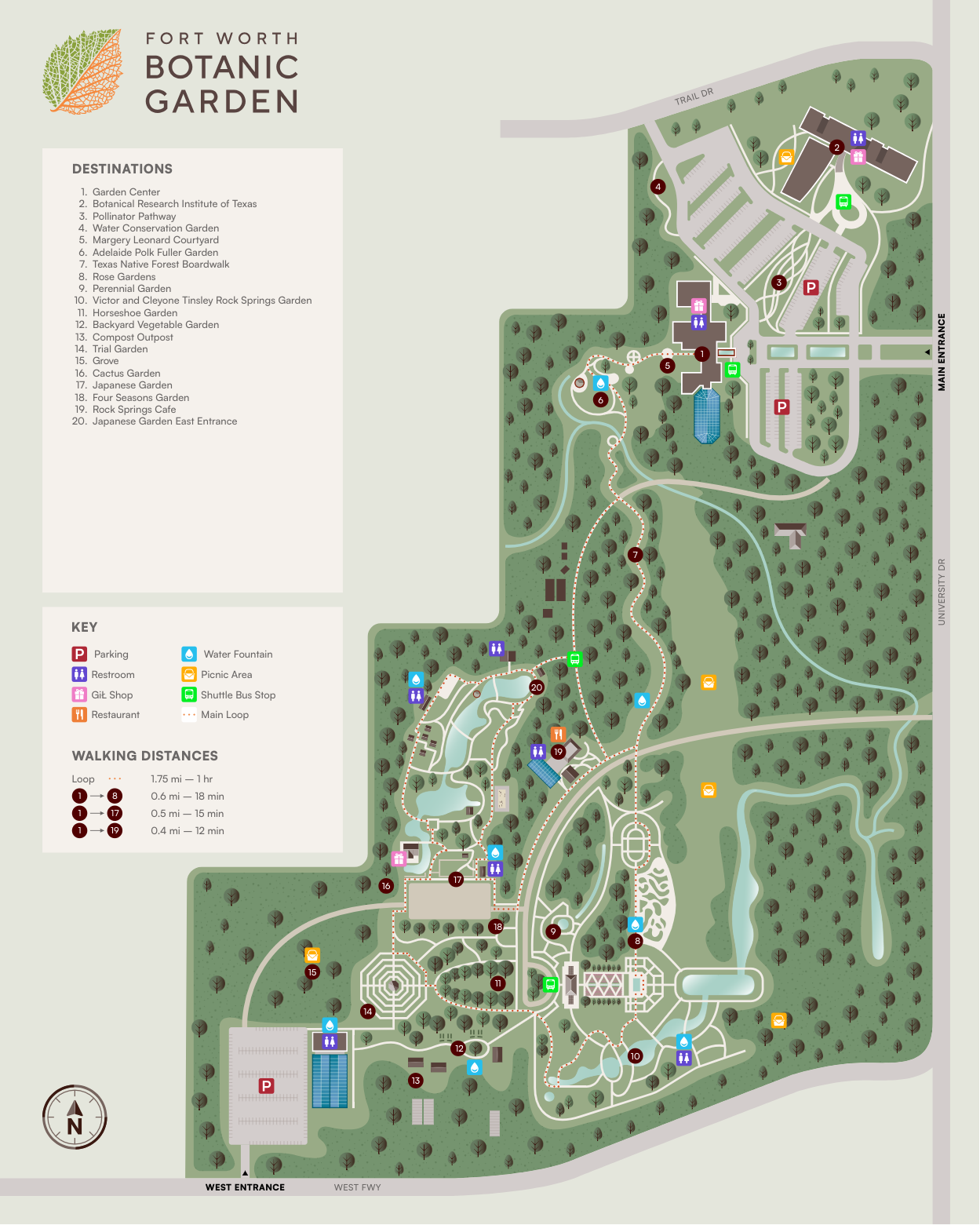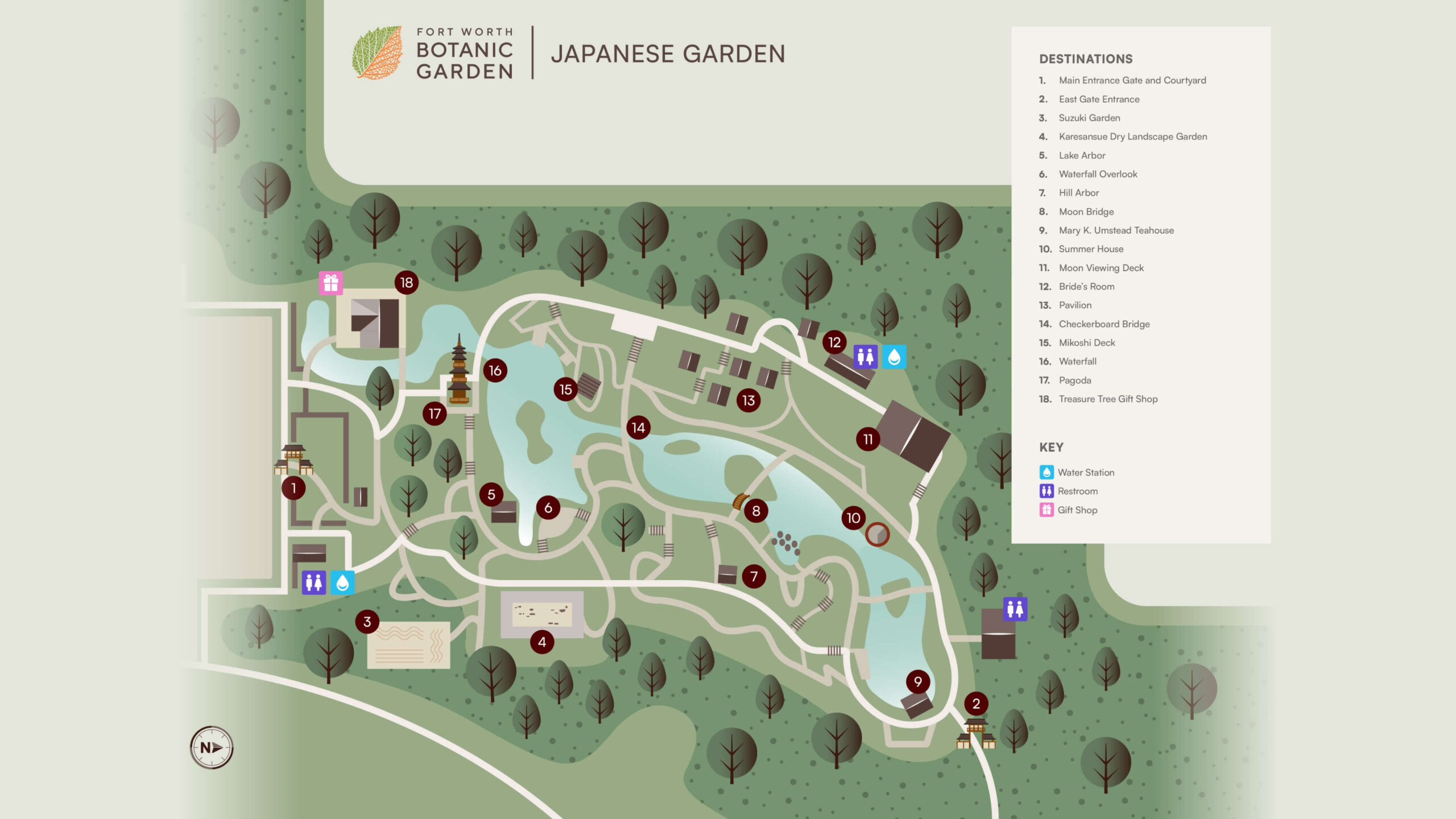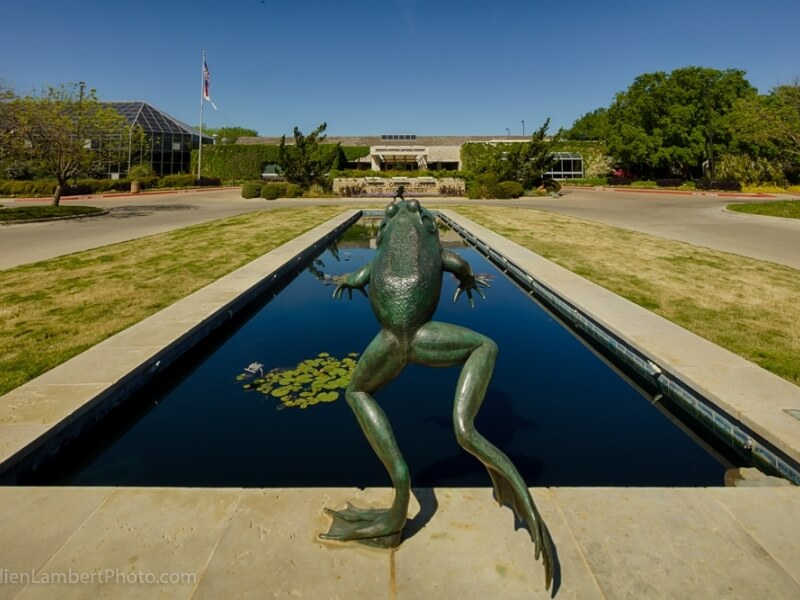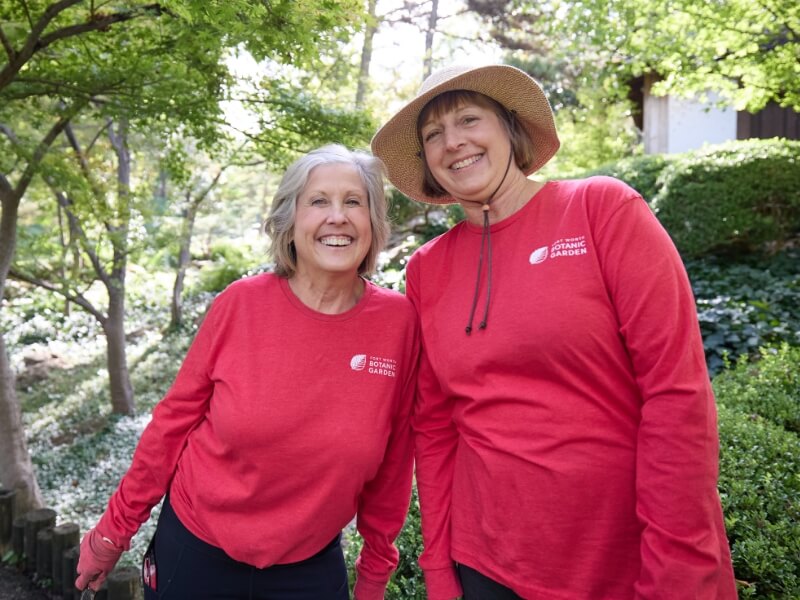Interactive Map
Click on the numbers below to learn more about that location.


-
The Garden Center was dedicated in 1986 and is located at the entrance of the Botanic Garden. It is home to the Conservatory and offers 17,000 square feet of offices, rentable space, an auditorium, and more.
BRIT research staff strives to incorporate the “three Ds” into each of our projects: discovery, documentation, and dissemination. Our researchers generally focus their projects around the themes of Biodiversity, Evolution, and Conservation, incorporating and contributing to our world-class Collections. Participating in a variety of projects at the state, national, and international level, our researchers are always on the go…and always learning. The Botanical Research Institute of Texas is dedicated to providing the community with world-class research in every project.
The Water Conservation Garden is located north of the Garden Center. This Garden is a blend of native and adapted plants that flourish on little water and produce an abundance of color between April and October.
Margery Leonard Courtyard is a flower-filled patio at the entrance of the garden. The Leonard Courtyard is only available for rental after the garden has closed and is perfect for a transitional cocktail hour between a ceremony and reception.
The Fuller Garden is a 3.5 acre lighted display garden that highlights a dynamic representation of stone hardscapes, trellises, water features, and seasonal color plantings. The Fuller Garden also includes a comprehensive collection of trees, shrubs, perennials, and turf.
The Native Texas Boardwalk is a living outdoor classroom. This elevated walkway was planted with native species growing on the east side and nonnative species growing on the west side. There are thirteen educational stations for children along the way, such as a hollow log, speaking tubes, and balance beams.
One of the most romantic gardens and on the National Register of Historic Places, the Rose Garden was built with 4,000 tons of Palo Pinto County sandstone and completed in 1933. After years of work, the Rose Garden was rededicated on October 15, 2017. This premier garden should be on your “do not miss” list.
The Perennial Garden is a year-round experience with both wet and dry, shady and sunny areas. Spring and autumn bring beautiful bursts of color while other plants thrive under the summer sun. Even in winter, this garden is rarely bare of blooms. Bulbs and shrubs enhance the landscape, adding to the continuity of color and form.
Rock Springs is the oldest of all the gardens in the Botanic Garden, and a part of the original 37.5 acres purchased in 1912. The City Forester, Raymond C. Morrison, supervised the construction of Rock Springs Park and channeled the three natural springs into streams, ponds, and waterfalls and used Palo Pinto County sandstone to create walkways along the rivulets and ponds. Construction was completed in 1936. The building of Interstate 30 in the 1950s compressed the natural springs that gave the garden its name, and water was pumped from the Trinity River to try to revive the area.
The Horseshoe is located between the Trial Garden and Rose Garden. Majestic live oaks and perennials line this lush lawn. At the western end, steps lead up to the Trial Garden.
The Backyard Vegetable Garden is a working garden filled with vegetable beds, fruit trees and a greenhouse.
The Trial Garden is located in the South part of the Botanic Garden directly across the street from the Rose Garden. The Trial Garden is made up of multiple beds bursting with foliage, in the middle is a beautiful wooden gazebo.
The Grove is located behind the Trial Garden. It’s a moderately wooded area home to large oak trees. The Grove is the site of our bi-annual Plant Sale as well as our large tented weddings.
The Cactus Garden and its greenhouse are tucked away at the end of the parking lot by the Japanese Garden. In 1935, the original Cactus Garden was established at Rock Springs Park. The Cactus Garden was recreated in 1995 in cooperation with the Fort Worth Cactus and Succulent Society (FWCSS) to bring cactus from different Texas counties to Fort Worth with the specimens being selected and planted by the FWCSS. Their recent concentration has been on cactus that will grow in north central Texas.
The Fort Worth Japanese Garden was completed in 1973. It is a traditional strolling garden with winding paths through the landscapes and around ponds. The garden consists of 7.5 acres filled with cherry trees, Japanese maples, magnolias, bamboo, bridges, and ponds filled with koi fish.
The Four Seasons Garden, located between the Horseshoe and Japanese Garden, was a gift from Gordon Scarborough in memory of his wife, Dolores. Finished in 1995, the garden features both sculptures and plants that represent the four seasons. A meandering path winds past beds filled with a charming assortment of annuals, perennials, trees, and shrubs.
Rock Springs Café, located in the Rock Springs Building, offers delicious bistro-style food and drinks to enjoy inside the café, on our covered patio, or to-go. Whether you are looking for a latte, a glass of wine, or a garden-made lunch, the café is the place to stop during your visit to the Garden.
Deborah Beggs Moncrief Garden Center
The Garden Center was dedicated in 1986 and is located at the entrance of the Botanic Garden. It is home to the Conservatory and offers 17,000 square feet of offices, rentable space, an auditorium, and more.
Research at the Botanical Research Institute of Texas
BRIT research staff strives to incorporate the “three Ds” into each of our projects: discovery, documentation, and dissemination. Our researchers generally focus their projects around the themes of Biodiversity, Evolution, and Conservation, incorporating and contributing to our world-class Collections. Participating in a variety of projects at the state, national, and international level, our researchers are always on the go…and always learning. The Botanical Research Institute of Texas is dedicated to providing the community with world-class research in every project.
Pollinator Pathway
Water Conservation Garden
The Water Conservation Garden is located north of the Garden Center. This Garden is a blend of native and adapted plants that flourish on little water and produce an abundance of color between April and October.
Margery Leonard Courtyard
Margery Leonard Courtyard is a flower-filled patio at the entrance of the garden. The Leonard Courtyard is only available for rental after the garden has closed and is perfect for a transitional cocktail hour between a ceremony and reception.
Adelaide Polk Fuller Garden
The Fuller Garden is a 3.5 acre lighted display garden that highlights a dynamic representation of stone hardscapes, trellises, water features, and seasonal color plantings. The Fuller Garden also includes a comprehensive collection of trees, shrubs, perennials, and turf.
Texas Native Forest Boardwalk
The Native Texas Boardwalk is a living outdoor classroom. This elevated walkway was planted with native species growing on the east side and nonnative species growing on the west side. There are thirteen educational stations for children along the way, such as a hollow log, speaking tubes, and balance beams.
The Rose Garden
One of the most romantic gardens and on the National Register of Historic Places, the Rose Garden was built with 4,000 tons of Palo Pinto County sandstone and completed in 1933. After years of work, the Rose Garden was rededicated on October 15, 2017. This premier garden should be on your “do not miss” list.
Perennial Garden
The Perennial Garden is a year-round experience with both wet and dry, shady and sunny areas. Spring and autumn bring beautiful bursts of color while other plants thrive under the summer sun. Even in winter, this garden is rarely bare of blooms. Bulbs and shrubs enhance the landscape, adding to the continuity of color and form.
Victor and Cleyone Tinsley Rock Springs Garden
Rock Springs is the oldest of all the gardens in the Botanic Garden, and a part of the original 37.5 acres purchased in 1912. The City Forester, Raymond C. Morrison, supervised the construction of Rock Springs Park and channeled the three natural springs into streams, ponds, and waterfalls and used Palo Pinto County sandstone to create walkways along the rivulets and ponds. Construction was completed in 1936. The building of Interstate 30 in the 1950s compressed the natural springs that gave the garden its name, and water was pumped from the Trinity River to try to revive the area.
Horseshoe Garden
The Horseshoe is located between the Trial Garden and Rose Garden. Majestic live oaks and perennials line this lush lawn. At the western end, steps lead up to the Trial Garden.
Backyard Vegetable Garden
The Backyard Vegetable Garden is a working garden filled with vegetable beds, fruit trees and a greenhouse.
Compost Outpost
Trial Garden
The Trial Garden is located in the South part of the Botanic Garden directly across the street from the Rose Garden. The Trial Garden is made up of multiple beds bursting with foliage, in the middle is a beautiful wooden gazebo.
The Grove
The Grove is located behind the Trial Garden. It’s a moderately wooded area home to large oak trees. The Grove is the site of our bi-annual Plant Sale as well as our large tented weddings.
Cactus Garden
The Cactus Garden and its greenhouse are tucked away at the end of the parking lot by the Japanese Garden. In 1935, the original Cactus Garden was established at Rock Springs Park. The Cactus Garden was recreated in 1995 in cooperation with the Fort Worth Cactus and Succulent Society (FWCSS) to bring cactus from different Texas counties to Fort Worth with the specimens being selected and planted by the FWCSS. Their recent concentration has been on cactus that will grow in north central Texas.
Japanese Garden
The Fort Worth Japanese Garden was completed in 1973. It is a traditional strolling garden with winding paths through the landscapes and around ponds. The garden consists of 7.5 acres filled with cherry trees, Japanese maples, magnolias, bamboo, bridges, and ponds filled with koi fish.
Four Seasons Garden
The Four Seasons Garden, located between the Horseshoe and Japanese Garden, was a gift from Gordon Scarborough in memory of his wife, Dolores. Finished in 1995, the garden features both sculptures and plants that represent the four seasons. A meandering path winds past beds filled with a charming assortment of annuals, perennials, trees, and shrubs.
Rock Springs Café
Rock Springs Café, located in the Rock Springs Building, offers delicious bistro-style food and drinks to enjoy inside the café, on our covered patio, or to-go. Whether you are looking for a latte, a glass of wine, or a garden-made lunch, the café is the place to stop during your visit to the Garden.
Japenese Garden East Gate
Picnics at the Garden
Enjoy the Garden’s serene beauty with a delightful picnic in our designated areas. By following a few simple guidelines, you help preserve this natural oasis for everyone. Prefer a curated meal? Stop by Rock Springs Café for lunch, brunch, coffee, or a picnic-to-go. We appreciate your support in keeping the Gardens a peaceful retreat.
- Picnics are allowed only in the following areas (View map below):
- North & South Vista
- East Vista
- The Grove
- Under the Oaks at the BRIT Geology Wall
- School groups, please call (817) 332-4441 ext. 270 to request approval to picnic in the Grove. All groups are asked to leave the area as they found it.
- Please pack out what you brought in.
- Dispose of all trash in designated recycle bins and trashcans.
- Be mindful of other guests and help keep the Gardens relaxing and peaceful.
- Please do not step into the cultivated garden beds or pick or cut any of the flowers or plants
- Leave tables, outside alcohol, large coolers, and folding chairs at home. These items damage garden spaces and detract from their serenity.
- Only feed our Koi fish the approved fish food available at admission or gift shops.
- Please note that we do not have picnic tables.
- On-site dining options are also available at Rock Springs Cafe. View our menus below:
Japanese Garden Map
More from:
More ways to get involved with the Fort Worth Botanic Garden




